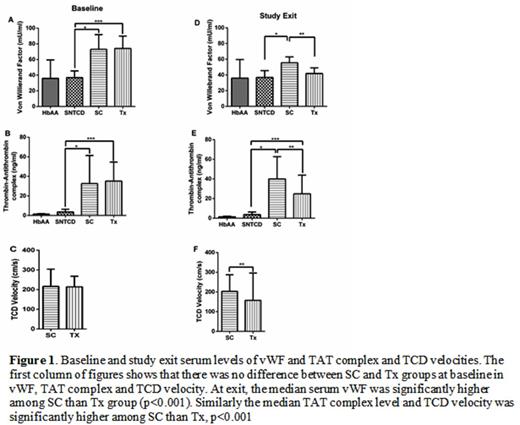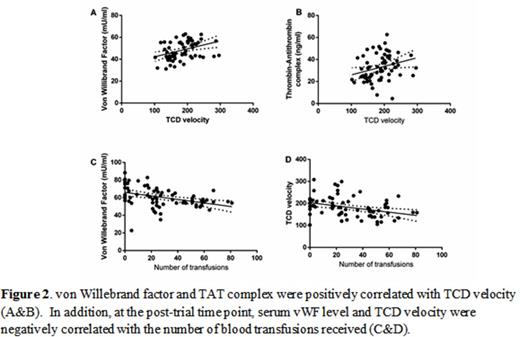Abstract
Sickle cell disease (SCD) is associated with global activation of procoagulant and proinflammatory molecules and an increased tendency to thrombosis and development of stroke. High TCD velocity is associated with increased risk for stroke and we have shown that high TCD velocity positively correlates with high serum levels of platelet derived growth factor (PDGF)–AA. Further, high frequency of packed red blood cell (PRBC) transfusion was associated with lower serum levels of PDGF-AA, sVCAM-1 and total plasminogen activator inhibitor (tPAI)–1. Lower baseline serum levels of PDGF-AA, sVCAM-1 and tPAI-1was associated with significantly higher stroke free survival. Other studies have shown that high levels of thrombin-antithrombin (TAT) complex and von Willebrand factor (vWF) is associated with acute chest syndrome and other SCD complications. There is paucity of information in their relationship with SCD associated stroke or the effect of chronic PRBC transfusion these markers of coagulopathy in SCD. We hypothesized that serum levels of VWF, TAT and other markers of coagulopathy will decrease in response to chronic PRBC transfusion in subjects with high TCD velocity on transfusion for primary stroke prevention. Our hypothesis was tested using stored serum samples from the STOP study.
Stored serum samples (at baseline, study exit and one year post-trial) of subjects who were part of STOP trial, 40 from each arms (standard care [SC] and transfusion [Tx]) and at each time point of the trial (i.e. 80 at baseline, 80 at study exit and 80 at one year post-trial) were obtained and analyzed using enzyme linked immunosorbent assay (Abcam PLC., Cambridge, MA) for serum vWF and TAT complex levels. In addition, 10 samples each from children with SCD and Normal TCD velocity (SNTCD) and healthy controls (HbAA) were assayed for comparison. Briefly, samples and reagents were allowed to warm up to room temperature and assayed according to the manufacturer's protocols. Absorbance was read using a Softmax Pro (Molecular Devices LLC, Sunnyvale, CA) and concentration calculated based on a linear curve with an R2 of 0.95 or greater, generated using manufacturer provided standards. Data were presented in median with ranges. Bar graphs of median concentration with range against treatment arm at each time point were plotted. Similar bar graph of median TCD velocity against treatment arm was plotted for comparison with vWF and TAT complex at baseline and study exit respectively. Finally, scatter plots with regression line were used to show linear relationship between serum levels of vWF and TAT and number of blood transfusions from baseline to post-trial time point.
The characteristics of these subjects have already been published elsewhere. At baseline (figure 1A-C), there was no significant difference in median serum levels of vWF, TAT complex or median TCD velocity between SC and Tx groups, p>0.05. But vWF and TAT levels were significantly higher among SC or Tx than for either HbAA or SNTCD, p<0.001. At exit (figure 1D-F), the median vWF level was significantly lower in the Tx group [41.8 (28.6, 49.0) mU/ml], compared to 55.4 (42.7, 63.0) mU/ml in the SC group, p<0.001. Similarly, the median TAT complex levels were significantly lower in the Tx group [24.8 (4.5, 43.8) ng/ml] compared to the SC group [40.0 (13.9, 62.6) ng/ml], p<0.001. Correspondingly, the median TCD velocity was significantly lower in the Tx group [158 (102, 296) cm/s] compared to 203 (103, 287) cm/s in the SC group, p<0.001. Pearson's correlation analysis showed that high TCD velocity had a significant positive correlation with serum vWF (r=0.36, p=0.003) and TAT complex (r=0.27, p=0.03) (Figure 2A&B). The number of PRBC transfusion received by the end of the post-trial period showed significant negative correlation with serum vWF (r=-0.39, p<0.001) and TCD velocity (r=-0.34, p=0.004) (Figure 2C&D). But, there was no significant correlation between hemoglobin levels and either TCD velocity or serum levels of vWF or TAT complex (data not shown).
We have found that individuals with SCA and high stroke risk have higher levels of vWF and TAT complex at baseline. Blood transfusions lowered these levels and TCD velocities in the high risk subjects. Thrombosis may play a role in the pathobiology of stroke in SCD and blood transfusions to prevent stroke appear to reduce activation of coagulation. Prospective observational studies are warranted to confirm these findings.
No relevant conflicts of interest to declare.
Author notes
Asterisk with author names denotes non-ASH members.



This feature is available to Subscribers Only
Sign In or Create an Account Close Modal